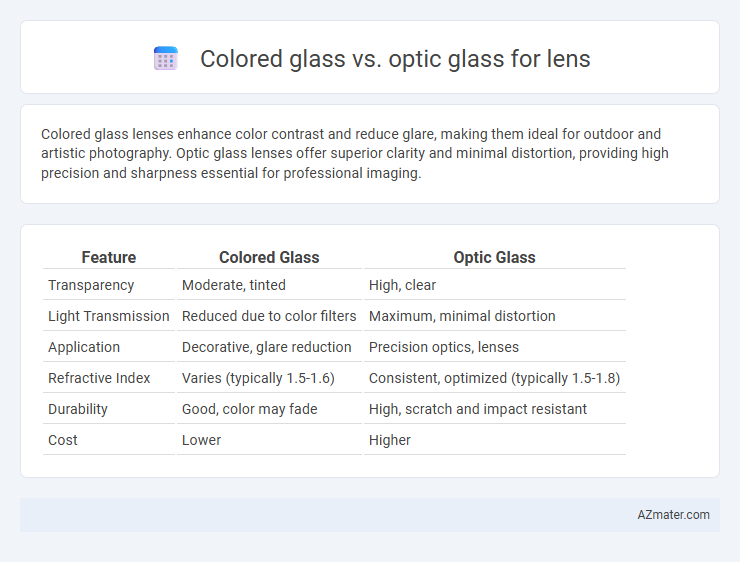Colored glass lenses enhance color contrast and reduce glare, making them ideal for outdoor and artistic photography. Optic glass lenses offer superior clarity and minimal distortion, providing high precision and sharpness essential for professional imaging.
Table of Comparison
| Feature | Colored Glass | Optic Glass |
|---|---|---|
| Transparency | Moderate, tinted | High, clear |
| Light Transmission | Reduced due to color filters | Maximum, minimal distortion |
| Application | Decorative, glare reduction | Precision optics, lenses |
| Refractive Index | Varies (typically 1.5-1.6) | Consistent, optimized (typically 1.5-1.8) |
| Durability | Good, color may fade | High, scratch and impact resistant |
| Cost | Lower | Higher |
Introduction to Lens Materials: Colored Glass vs Optic Glass
Colored glass lenses offer specific wavelength filtration and aesthetic customization by incorporating metal oxides during manufacture, enhancing contrast and reducing glare in optical devices. Optic glass, typically high-purity silica-based material with precise refractive indices, provides superior clarity, minimal dispersion, and higher resistance to environmental factors, making it ideal for high-performance lenses. The choice between colored glass and optic glass depends on application requirements such as color filtering, chromatic aberration control, and environmental durability.
Composition and Properties of Colored Glass
Colored glass for lenses contains metal oxides such as cobalt, chromium, or iron that impart specific hues, enhancing optical filtering capabilities by selectively absorbing wavelengths. It exhibits higher light absorption and reduced transmission compared to optic glass, which is typically composed of borosilicate or crown glass offering superior clarity and low dispersion. While colored glass provides aesthetic and functional coloration, optic glass maintains higher refractive index uniformity and is favored for precision imaging applications.
Optical Characteristics of Optic Glass
Optic glass exhibits superior optical characteristics compared to colored glass, including higher refractive index and lower dispersion, which ensures minimal chromatic aberration and sharper image quality. Its enhanced homogeneity and controlled chemical composition contribute to better light transmission and reduced optical distortions critical for precision lenses. These properties make optic glass ideal for applications demanding high clarity, color accuracy, and visual performance.
Light Transmission and Color Accuracy
Colored glass lenses typically reduce light transmission due to tinting that filters specific wavelengths, which can affect brightness but enhance certain color contrasts. Optic glass lenses, designed with high purity and precise refractive indices, provide superior light transmission and maintain true-to-life color accuracy, crucial for applications requiring precise visual fidelity. The choice impacts optical performance significantly; optic glass ensures minimal color distortion and maximum clarity, while colored glass can selectively enhance or suppress colors depending on the tint.
Durability and Longevity Comparison
Colored glass lenses often experience reduced durability due to the incorporation of dyes that can degrade under prolonged exposure to sunlight and environmental factors. Optic glass, typically made from high-quality silica with optimized refractive properties, offers superior longevity and resistance to wear, maintaining clarity and performance over extended use. The enhanced structural integrity of optic glass makes it a preferred choice in professional lens applications where consistent durability and long-term optical precision are critical.
Application Suitability: When to Choose Colored Glass
Colored glass lenses are ideal for applications requiring specific light filtration, such as enhancing contrast in photography or reducing glare in automotive optics. These lenses selectively absorb certain wavelengths, making them suitable for environments with variable lighting conditions and for improving visual comfort during prolonged use. Optic glass, by contrast, excels in situations demanding high precision and minimal distortion, but lacks the targeted filtering properties of colored glass.
Precision and Clarity in Optic Glass Lenses
Optic glass lenses offer superior precision and clarity compared to colored glass, as they are engineered with higher purity and controlled refractive indices to minimize optical distortions. The manufacturing processes for optic glass, including precise grinding and polishing, ensure consistent focal properties crucial for high-resolution imaging applications. Colored glass lenses often introduce chromatic aberration and reduce light transmission, making optic glass the preferred choice for capturing sharp, accurate images in scientific and photographic instruments.
Cost Differences and Economic Considerations
Colored glass lenses typically incur higher production costs due to specialized pigmentation processes that increase material and manufacturing expenses. Optic glass, designed for clarity and precision, often presents a cost-effective alternative with lower raw material costs and streamlined fabrication techniques. Economic considerations favor optic glass for budget-conscious projects requiring high optical performance without added coloration.
Environmental Impact of Lens Materials
Colored glass lenses often contain heavy metals and pigments that can pose environmental hazards during manufacturing and disposal, leading to potential soil and water contamination. Optic glass lenses typically use purer raw materials and advanced refining processes that reduce harmful emissions and improve recyclability, minimizing ecological footprint. Choosing optic glass over colored glass can significantly lower environmental impact by reducing toxic waste and enhancing material recovery in lens production.
Final Verdict: Selecting the Right Lens Material
Optic glass offers superior clarity, minimal distortion, and higher light transmission, making it the preferred choice for precision lenses in cameras, microscopes, and telescopes. Colored glass lenses, while useful for specific filtering and aesthetic purposes, often introduce chromatic aberration and reduce optical performance. For applications demanding accuracy and image quality, optic glass is the optimal lens material.

Infographic: Colored glass vs Optic glass for Lens
 azmater.com
azmater.com